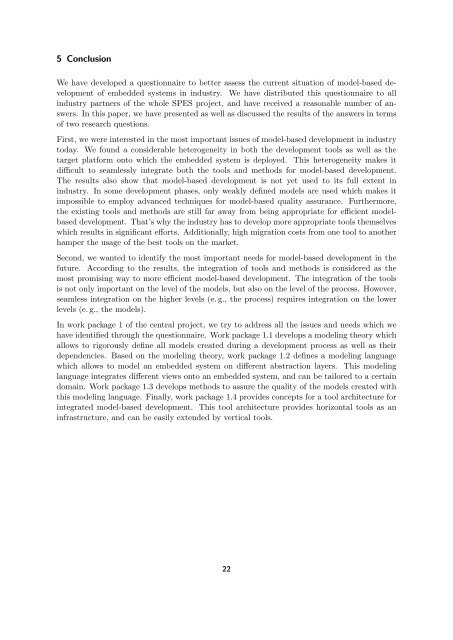SPES 2020 Deliverable 1.4.B-1 Result of the Tool Questionnaire
SPES 2020 Deliverable 1.4.B-1 Result of the Tool Questionnaire
SPES 2020 Deliverable 1.4.B-1 Result of the Tool Questionnaire
You also want an ePaper? Increase the reach of your titles
YUMPU automatically turns print PDFs into web optimized ePapers that Google loves.
5 Conclusion<br />
We have developed a questionnaire to better assess <strong>the</strong> current situation <strong>of</strong> model-based development<br />
<strong>of</strong> embedded systems in industry. We have distributed this questionnaire to all<br />
industry partners <strong>of</strong> <strong>the</strong> whole <strong>SPES</strong> project, and have received a reasonable number <strong>of</strong> answers.<br />
In this paper, we have presented as well as discussed <strong>the</strong> results <strong>of</strong> <strong>the</strong> answers in terms<br />
<strong>of</strong> two research questions.<br />
First, we were interested in <strong>the</strong> most important issues <strong>of</strong> model-based development in industry<br />
today. We found a considerable heterogeneity in both <strong>the</strong> development tools as well as <strong>the</strong><br />
target platform onto which <strong>the</strong> embedded system is deployed. This heterogeneity makes it<br />
difficult to seamlessly integrate both <strong>the</strong> tools and methods for model-based development.<br />
The results also show that model-based development is not yet used to its full extent in<br />
industry. In some development phases, only weakly defined models are used which makes it<br />
impossible to employ advanced techniques for model-based quality assurance. Fur<strong>the</strong>rmore,<br />
<strong>the</strong> existing tools and methods are still far away from being appropriate for efficient modelbased<br />
development. That’s why <strong>the</strong> industry has to develop more appropriate tools <strong>the</strong>mselves<br />
which results in significant efforts. Additionally, high migration costs from one tool to ano<strong>the</strong>r<br />
hamper <strong>the</strong> usage <strong>of</strong> <strong>the</strong> best tools on <strong>the</strong> market.<br />
Second, we wanted to identify <strong>the</strong> most important needs for model-based development in <strong>the</strong><br />
future. According to <strong>the</strong> results, <strong>the</strong> integration <strong>of</strong> tools and methods is considered as <strong>the</strong><br />
most promising way to more efficient model-based development. The integration <strong>of</strong> <strong>the</strong> tools<br />
is not only important on <strong>the</strong> level <strong>of</strong> <strong>the</strong> models, but also on <strong>the</strong> level <strong>of</strong> <strong>the</strong> process. However,<br />
seamless integration on <strong>the</strong> higher levels (e. g., <strong>the</strong> process) requires integration on <strong>the</strong> lower<br />
levels (e. g., <strong>the</strong> models).<br />
In work package 1 <strong>of</strong> <strong>the</strong> central project, we try to address all <strong>the</strong> issues and needs which we<br />
have identified through <strong>the</strong> questionnaire. Work package 1.1 develops a modeling <strong>the</strong>ory which<br />
allows to rigorously define all models created during a development process as well as <strong>the</strong>ir<br />
dependencies. Based on <strong>the</strong> modeling <strong>the</strong>ory, work package 1.2 defines a modeling language<br />
which allows to model an embedded system on different abstraction layers. This modeling<br />
language integrates different views onto an embedded system, and can be tailored to a certain<br />
domain. Work package 1.3 develops methods to assure <strong>the</strong> quality <strong>of</strong> <strong>the</strong> models created with<br />
this modeling language. Finally, work package 1.4 provides concepts for a tool architecture for<br />
integrated model-based development. This tool architecture provides horizontal tools as an<br />
infrastructure, and can be easily extended by vertical tools.<br />
22
















